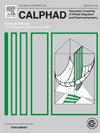Thermodynamic investigation on ion structure of LiF-PrF3-Pr6O11 melt
IF 1.9
3区 材料科学
Q4 CHEMISTRY, PHYSICAL
Calphad-computer Coupling of Phase Diagrams and Thermochemistry
Pub Date : 2025-07-31
DOI:10.1016/j.calphad.2025.102863
引用次数: 0
Abstract
The ionic behavior in the LiF-PrF3-Pr6O11 melt system is of critical importance for the praseodymium reduction process. This study investigates the effects of the LiF/PrF3 molar ratio (CR, n(LiF)/n(PrF3)) and temperature on the ionic species and their concentrations in melt through quantum chemical calculations and thermodynamic analysis. The results indicate that in the LiF-PrF3 melt, the dominant anions are [PrF4]-, [PrF6]3-, [PrF7]4-, [Pr2F7]- and F−. As the CR increases, the melt tends to form [PrFx]3−x anions with higher fluoride coordination numbers. With rising temperature, the complex ions in the melt transform into simpler ionic species. Upon dissolving of Pr6O11 in the LiF-PrF3 melt, the predominant anionic species formed are [PrOF6]5-, [Pr2OF5]-, [Pr2OF8]4-, [Pr2OF9]5- and [Pr2OF10]6-. An increase in CR promotes the transformation of [Pr2OFx]4−x anions into structures with higher fluoride coordination numbers. Simultaneously, the content of [PrOF6]5- anions increases progressively, and when the CR exceeds 3, [PrOF6]5- becomes the dominant anionic species in the melt. Increasing the melt temperature inhibits the coordination reactions of [Pr2OFx]4−x anions and accelerates their dissociation into [PrOFx]1−x anions.
LiF-PrF3-Pr6O11熔体离子结构的热力学研究
LiF-PrF3-Pr6O11熔体体系中的离子行为对镨还原过程至关重要。通过量子化学计算和热力学分析,研究了LiF/PrF3摩尔比(CR, n(LiF)/n(PrF3))和温度对熔体中离子种类及其浓度的影响。结果表明,在LiF-PrF3熔体中,主要阴离子为[PrF4]-、[PrF6]3-、[PrF7]4-、[Pr2F7]-和F−。随着CR的增加,熔体倾向于形成具有较高氟配位数的[PrFx]3−x阴离子。随着温度的升高,熔体中的络合离子转变为较简单的离子。当Pr6O11在LiF-PrF3熔体中溶解时,形成的主要阴离子种类是[pro6]5-, [Pr2OF5]-, [Pr2OF8]4-, [Pr2OF9]5-和[Pr2OF10]6-。CR的增加促进[Pr2OFx]4−x阴离子转化为具有更高氟配位数的结构。同时,[PrOF6]5-阴离子含量逐渐增加,当CR大于3时,[PrOF6]5-成为熔体中的优势阴离子。升高熔体温度抑制了[Pr2OFx]4−x阴离子的配位反应,加速了它们解离成[prox]1−x阴离子。
本文章由计算机程序翻译,如有差异,请以英文原文为准。
求助全文
约1分钟内获得全文
求助全文
来源期刊
CiteScore
4.00
自引率
16.70%
发文量
94
审稿时长
2.5 months
期刊介绍:
The design of industrial processes requires reliable thermodynamic data. CALPHAD (Computer Coupling of Phase Diagrams and Thermochemistry) aims to promote computational thermodynamics through development of models to represent thermodynamic properties for various phases which permit prediction of properties of multicomponent systems from those of binary and ternary subsystems, critical assessment of data and their incorporation into self-consistent databases, development of software to optimize and derive thermodynamic parameters and the development and use of databanks for calculations to improve understanding of various industrial and technological processes. This work is disseminated through the CALPHAD journal and its annual conference.

 求助内容:
求助内容: 应助结果提醒方式:
应助结果提醒方式:


